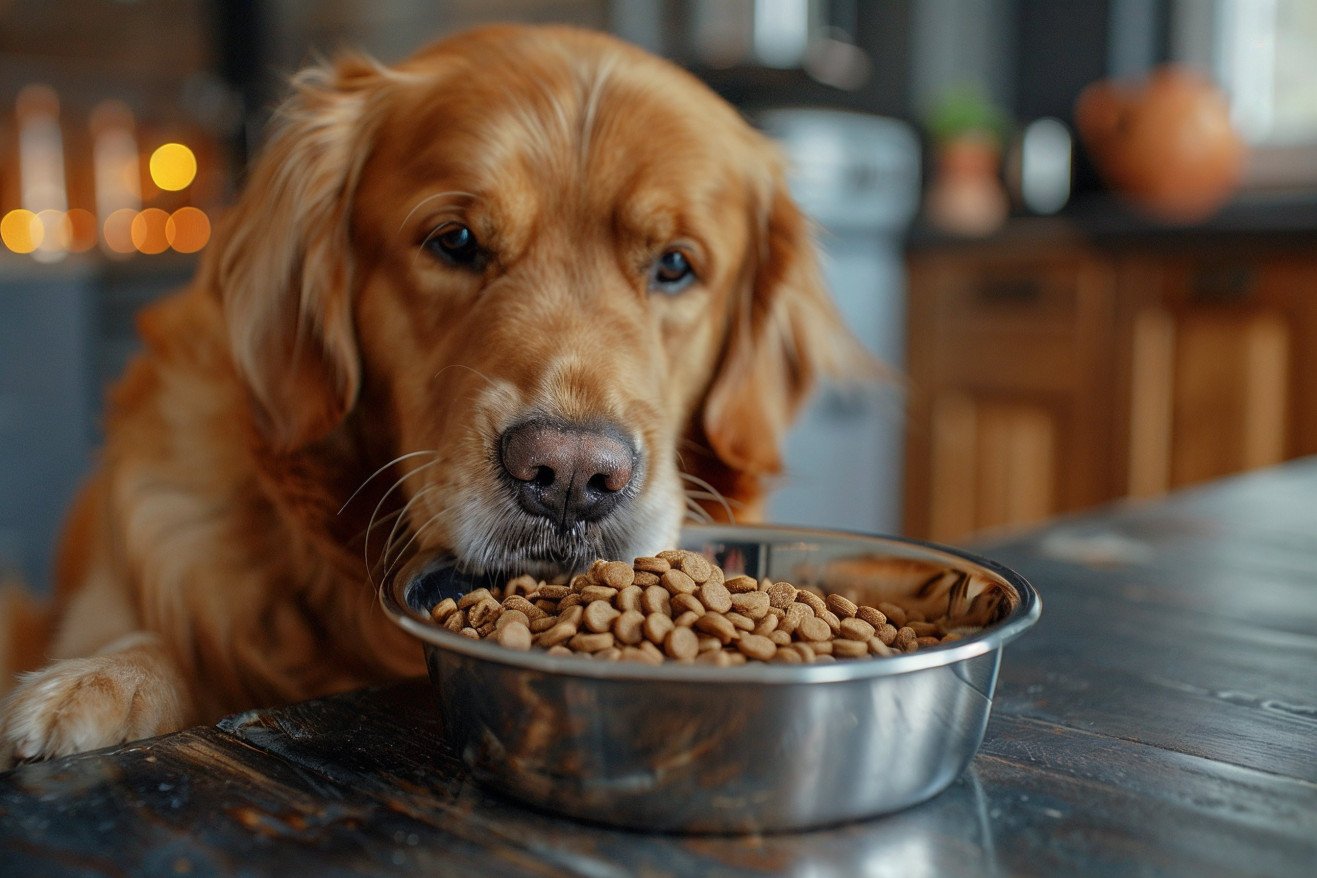Is Kibble Bad for Dogs? Exploring Healthier Diet Alternatives
5 May 2024 • Updated 4 May 2024

The controversy surrounding kibble, which is a main component of most commercial dog foods, has led many dog owners to question the safety and nutritional value of this type of dog food. Kibble is bad for dogs because it is high in carbohydrates, contains low-quality proteins and rendered fats, and is low in moisture, which can cause urinary and digestive problems in the long run.
In this article, we will explore the work of veterinary nutritionists and animal researchers who have studied the effects of different types of dog food. Their studies have shown the impact of kibble on dogs and can help dog owners understand how to feed their pets healthier, more nutritious options. By learning about fresh, raw, and home-cooked dog food, you will walk away with a better understanding of how to feed your dog a balanced, species-appropriate diet.
Is kibble bad for dogs?
The Risks of Kibble: What the Research Says
The risks of feeding dogs a kibble diet have been well-documented by scholars and studies. One of the most pressing concerns is the use of low-quality ingredients such as rendered fats, fillers, and by-products, all of which can have a negative impact on dogs' health according to Raw Bistro. In addition, the high heat extrusion process used to make kibble destroys many of the essential nutrients in the food, as shown in this study on toxins in pet food.
Moreover, the high carbohydrate content in many kibble formulas is not in line with dogs' natural carnivorous diets, as explained by Dog's Naturally Magazine. This high-carb content can lead to obesity, diabetes, and other metabolic issues in dogs.
Even more worrying is the potential for contamination in commercial pet foods, including molds, carcinogens such as acrylamide and heterocyclic amines, and toxins such as aflatoxins and PBDEs (polybrominated diphenyl ethers). Dog Nutrition Naturally explains that these substances can lead to a range of health problems, including cancer, liver failure, and premature death.
Given the many risks of many commercial kibble diets, it may be important to consider alternative fresh food options for a dog's long-term health. The next section takes a look at the rise of the raw food movement and its potential advantages.
The Raw Food Revolution: Pros and Cons
The raw food revolution has become increasingly popular as an alternative to traditional kibble-based dog diets. A raw, whole food diet is made up of fresh, unprocessed foods like muscle meat, organ meat, bones, and vegetables. Raw food proponents have claimed a number of benefits for their dogs, including better digestion, shinier coats, and more energy, according to WebMD.
Studies have also shown that raw-fed dogs have a lower risk of certain chronic diseases and may even live longer than dogs that eat commercial kibble. However, a study in the Journal of the American Veterinary Association found that every raw diet they analyzed had nutritional imbalances that could lead to serious health problems if the diet was fed long-term.
Despite the potential benefits of raw feeding, there are also potential drawbacks. For example, raw meat can contain bacteria like Salmonella and Listeria, which can be dangerous for dogs and people. It's important to handle and prepare raw food carefully. In addition, it may be difficult to ensure that a raw diet is nutritionally complete and balanced without the help of a veterinary nutritionist, according to this PMC study.
The next section will take a look at homemade dog food as a way to provide personalized nutrition for your dog.
Homemade Diets: A Personalized Way to Feed Your Dog
The trend of feeding dogs homemade food has grown in response to the rise of commercial kibble and raw diets. One of the biggest benefits of homemade diets is that pet parents can control the ingredients and make sure their dog gets exactly what they need, according to this PetMD article. However, it’s important to make sure that homemade diets are nutritionally complete and balanced. An investigation by UC Davis showed that the majority of homemade dog food recipes were deficient in at least one essential nutrient.
To ensure that homemade diets are nutritionally complete and balanced and to determine the right portion sizes, The Spruce Pets suggests that pet parents work with their veterinarians or a board-certified veterinary nutritionist. These professionals can help pet parents make sure that their dog’s diet is nutritionally balanced and that it meets their dog’s specific needs for calories, protein, fat, vitamins, and minerals. While homemade diets take more time and effort than other types of diets, the ability to personalize the diet is a major advantage for some dogs.
In addition to making sure that homemade diets are nutritionally balanced, pet parents need to make sure that they store and handle the food properly, according to PetMD. Pet parents should also monitor their dog’s health and weight when they first switch to a homemade diet, as the change in diet can sometimes cause an upset stomach. With the right support and planning, homemade diets can be a healthy way to feed your dog.
How to Transition Your Dog to a New Diet
According to BJ's Raw Pet Food, it's important to transition dogs from kibble to raw or homemade dog food slowly. This is because a sudden change in diet can cause digestive upset, such as diarrhea or vomiting, since the gut microbiome needs time to adapt.
Raw Performance Dog Food describes two primary methods for transitioning dogs to a raw diet: the slow switch and the fast switch. The slow switch involves gradually increasing the amount of raw food over the course of a week, while the fast switch involves fasting the dog for 24 hours before starting the new diet. In both cases, it's important to watch the dog's reaction and adjust the transition as needed.
If your dog experiences digestive upset during the transition, it can be helpful to feed them a bland diet or give them digestive supplements, according to BJ's Raw Pet Food. After the transition, many dogs experience benefits such as increased energy and less smelly poop due to better nutrient absorption. It's important to work with a vet during the transition to ensure your dog's health and well-being. However, with the right care, dog owners can successfully switch their pets to a healthier diet.
How to Choose a Good Commercial Dog Food
While homemade and raw diets have their advantages, many dog owners find it easier to feed their pet a commercial dog food. According to The AKC, these foods are highly regulated and have been tested extensively by veterinary nutritionists. They include meat, vegetables, grains, and fruits in combinations that are appropriate for a dog's digestive system.
When shopping for commercial dog food, Whole Dog Journal says to look for real, whole food ingredients, named sources of meat, and the right levels of protein and fat. In addition, it's important to make sure the food meets AAFCO standards and is formulated by board-certified veterinary nutritionists and food scientists, according to Sunshine Pet Hospital.
It's also important to make sure the food you choose is appropriate for your dog's life stage, size, and any dietary restrictions or allergies. If you can find a food that meets all of these criteria, you can be confident that you're feeding your dog a healthy, complete diet.
Conclusion: Finding the Right Canine Diet for Your Dog
This article has looked at the potential drawbacks of kibble, as well as the benefits and drawbacks of raw and homemade diets. Throughout, it has emphasized the importance of working with veterinary professionals and doing thorough research before making any changes to a dog's diet.
There is no one-size-fits-all answer to the question of what to feed a dog. In many cases, the best solution may be to feed a combination of different types of diets or to rotate between different types of diets to meet a dog's individual needs and preferences. Other factors, such as cost, convenience, and lifestyle, will also play a role in determining the best diet for a dog.
In the end, the most important thing is to feed dogs a balanced, species-appropriate diet that supports their health and well-being. By prioritizing high-quality ingredients and seeking out expert advice, dog owners can ensure that their pets are getting the best possible nutrition.


